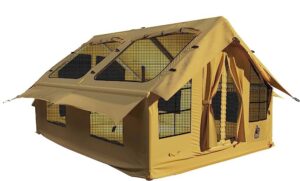How inflatable tent houses can help to reduce our carbon footprint
Inflatable tent houses are a brilliant solution to reduce our carbon footprint and make a positive impact on the environment. These innovative structures not only provide a comfortable living space but also offer numerous environmental benefits.
Firstly, inflatable tent houses are designed with sustainability in mind. Most of these tents are made from eco-friendly materials such as recyclable polyvinyl chloride (PVC), which significantly reduces the carbon emissions associated with traditional construction materials.
Additionally, inflatable tent houses require far less energy and resources to manufacture compared to their brick-and-mortar counterparts. The lightweight nature of these tents means that less transportation is needed during the production process, further lowering their carbon footprint.
Moreover, inflatable tent houses have excellent insulation properties, making them energy-efficient and reducing the need for excessive heating or cooling systems. The air-filled layers of these tents act as natural insulators, trapping heat during colder months and providing a cool shelter during hot summers.
This insulation not only helps to maintain a comfortable living environment but also minimizes reliance on electricity or fossil fuels for temperature regulation. Furthermore, inflatable tent houses often feature solar panels integrated into their design.
This ingenious addition harnesses solar energy to power the electrical appliances within the tent, reducing reliance on non-renewable sources of energy. By utilizing sunlight as an alternative power source, these tents contribute to lowering greenhouse gas emissions and promote sustainable living practices.
Inflatable tent houses offer an incredible opportunity to shrink our carbon footprint while maintaining a high level of comfort and functionality. From their eco-friendly construction materials to their energy-efficient insulation properties and integration of solar panels for renewable energy generation – all aspects work synergistically towards creating a more sustainable future for our planet.
Materials used to make inflatable tent houses
When it comes to the materials used in making inflatable tent houses, designers and manufacturers have put a great deal of thought into choosing sustainable and environmentally friendly options. These tents often utilize materials such as recyclable fabrics, eco-friendly coatings, and low-impact dyes. One common material used is PVC (Polyvinyl Chloride), which is chosen for its durability and flexibility.
However, concerns have been raised about the environmental impact of PVC production and disposal. To address this issue, many inflatable tent house manufacturers now use PVC that is free from harmful phthalates and other toxic additives.
Additionally, efforts are being made to recycle PVC-based materials at the end of their life cycle. Inflatable tent houses also incorporate fabrics like polyester or nylon for their lightweight properties.
However, it’s essential to note that not all polyester or nylon fabrics are created equal in terms of sustainability. Many manufacturers opt for recycled polyester or nylon to lessen the reliance on virgin resources.
These recycled fabrics are made from post-consumer plastic bottles or industrial waste, reducing the need for new raw materials and diverting waste from landfills. Some companies even go a step further by using organic cotton or hemp blends in their tent designs, providing a more natural alternative that minimizes environmental harm throughout its lifecycle.
The materials used in inflatable tent houses prioritize sustainability by incorporating recyclable fabrics like polyester and nylon while addressing concerns surrounding PVC production and disposal by opting for safer alternatives. These conscientious choices not only make these tents durable but also reduce their ecological footprint without compromising on performance or comfort.
Disposal of inflatable tent houses
When it comes to the disposal of inflatable tent houses, it is important to consider their environmental impact. While these innovative structures are designed to be durable and long-lasting, there may come a time when they need to be disposed of.
Fortunately, many manufacturers have taken steps to ensure that the disposal process is as eco-friendly as possible. One approach to environmentally conscious disposal is recycling.
Inflatable tent houses are typically made from PVC or other similar materials which can be recycled. Manufacturers often provide instructions on how to properly recycle the tents at the end of their lifecycle.
This involves separating the different components, such as the inflatable beams and fabric, and taking them to recycling facilities that specialize in processing these materials. By recycling inflatable tent houses, we can minimize waste and contribute to a more sustainable future.
Another option for disposing of inflatable tent houses is repurposing them for other uses. Due to their versatility and modular design, these structures can be transformed into various functional items even after they have served their initial purpose as a shelter.
For example, some creative individuals have turned old inflatable tents into garden covers or temporary storage units. By repurposing these structures instead of discarding them outright, we not only reduce waste but also give them a second life while minimizing our ecological footprint.
Moreover, some manufacturers offer take-back programs where customers can return their used inflatable tent houses directly to the company for proper disposal or refurbishment. This not only ensures responsible handling but also allows manufacturers to assess the condition of returned tents and make any necessary repairs before reselling or redistributing them for charitable purposes.
When it comes time for disposal of an inflatable tent house, several environmentally friendly options are available such as recycling or repurposing. By choosing responsible methods for disposing or reusing these structures rather than sending them straight to waste dumps, we can actively contribute towards reducing our impact on the environment while still enjoying the benefits offered by these innovative shelters.
Conclusion
Inflatable tent houses present a promising solution to reducing our carbon footprint and minimizing the negative impact on the environment. The use of eco-friendly materials and their lightweight nature make them an attractive alternative to traditional housing options. Not only do they provide a comfortable and practical living space, but they also offer the flexibility to easily relocate or store when not in use.
The materials used in inflatable tent houses are carefully chosen to ensure sustainability. Most manufacturers prioritize using recyclable and biodegradable materials that decrease environmental harm.
From eco-friendly PVC fabrics to ethically sourced bamboo poles, these tents are designed with both functionality and environmental consciousness in mind. When it comes to disposal, inflatable tent houses have an advantage over traditional homes.
Inflatable structures can be deflated, packed away, and stored without taking up much space. This allows for easy transportation and reduces waste during relocation or when the tents are no longer needed.
Additionally, many manufacturers offer recycling programs for old or damaged inflatable tent houses, further contributing to a more sustainable approach. In embracing inflatable tent houses as a viable housing option, we can make significant strides towards reducing our carbon footprint while still enjoying the comforts of home.
These innovative structures not only minimize construction waste but also encourage us to adopt a more conscious lifestyle by promoting eco-friendly practices. By choosing inflatable tent houses, we contribute positively towards preserving our environment for future generations while embracing a more flexible and versatile way of living.


